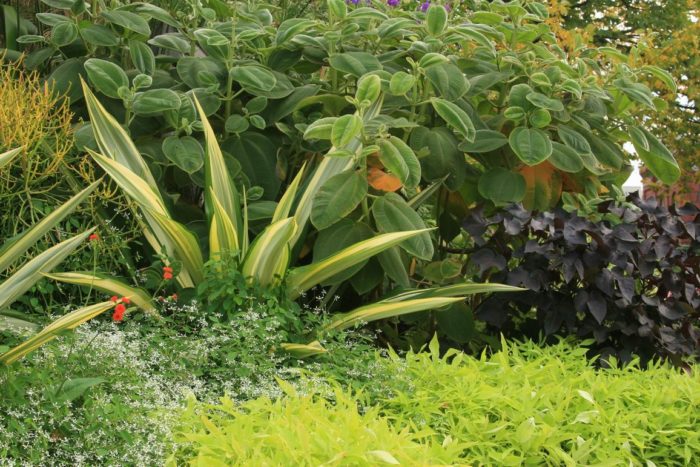
Photo/Illustration: Michelle Gervais

Photo/Illustration: Michelle Gervais
Furcraea (Furcraea foedita ‘Mediopicta’, USDA Hardiness Zone 11) is the focal point in this combo at the Mary Livingston Ripley Garden of the Smithsonian Institute in Washington, D.C. It’s backed up by a golden sweet potato vine (Ipomoea batatas cv., Zone 11), Diamond Frost euphorbia (Euphorbia ‘Inneuphdia’, Zones 10-11), a dark coleus (Solenostemon scutellarioides cv., Zone 11), a spiky orange and green pencil tree (Euphorbia tirucalli, Zone 11), fuzzy-leaved glory bush (Tibouchina sp, Zones 9-11), and a papyrus (Cyperus papyrus, Zone 11).
Welcome to the Fine Gardening GARDEN PHOTO OF THE DAY blog! Every weekday we post a new photo of a great garden, a spectacular plant, a stunning plant combination, or any number of other subjects. Think of it as your morning jolt of green.
Sign up to get new posts delivered to your inbox each morning so you’ll always remember to take a look, or subscribe to our RSS feed. We look forward to sharing our garden travels with you.
If you think you have a photo that we should share on the Garden Photo of the day, email us. Send hi-res images to [email protected] with GPOD in the subject line. We’ll only respond if we plan to use your photo.

















Comments
This is a lovely design but I think a boldly patterned maranta, one of the smaller dracaenas with green and yellow stripes, and perhaps a good old fashioned aspidistra (one with gold-flecked leaves would look particularly good) would work well here too. I'm surprised to see the plants in the photos doing so well in Washington DC so perhaps other tropical foliage plants will do well there also. Is this part of the garden under cover during winter, I wonder?
Great textures and color contrast, would be a fun combo for a big container! (Are the plants in a container?)
It seems unlikely to me, too, that some of these plants would survive winter here, although you do see century plants grown in area gardens. It's more likely that these are among the seasonal plants that Smithsonian gardeners rotate. This garden is a gem. Mary Livingston Ripley saved it from being a parking lot!
Hello all - glad to see the Smithsonian's Ripley Garden showing up at Fine Gardening! I have been the gardener here for the past 13 years and get to play with lots of fun plants. You are absolutely right about these things not being hardy in DC (zone 7B pushing an 8)
This planting area in early spring would have been hundreds of tulips and as soon as they are finished blooming, they all get composted and I bring out the tropicals from our greenhouses. I try to do something different every year, but some of the plants will reappear again and again in different combinations.
thanks for noticing the garden!
janet draper, horticulturist
Smithsonian Institution
janet,
terrific design AND maintenance! and michelle, thanks so much for i.d.ing all the plants in the photo. So helpful!
best,
mindy
http://www.cottonarboretum.com/
That purple-leaf plant isn't a coleus since it's got trifoliate leaves. The common name for Furcraea is "false agave." And the glorybush here is Tibouchina heteromalla (which is widely and incorrectly still listed as T. grandifolia). The USDA Zone ratings should be modified, as pencil cactus and false agaves are fine into Zone 9b, and this species of glorybush is best in Zone 10 and warmer.
BTW, when are y'all gonna use the expansive zones (13 to 15) in your magazine and website? They've been around since 2005. Can't talk tropicals without em.
Log in or create an account to post a comment.
Sign up Log in